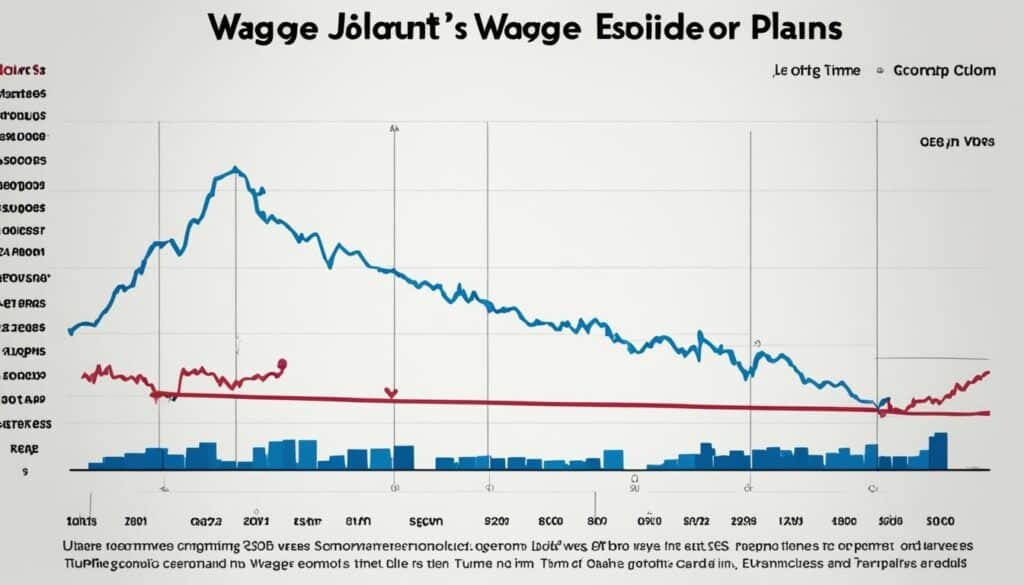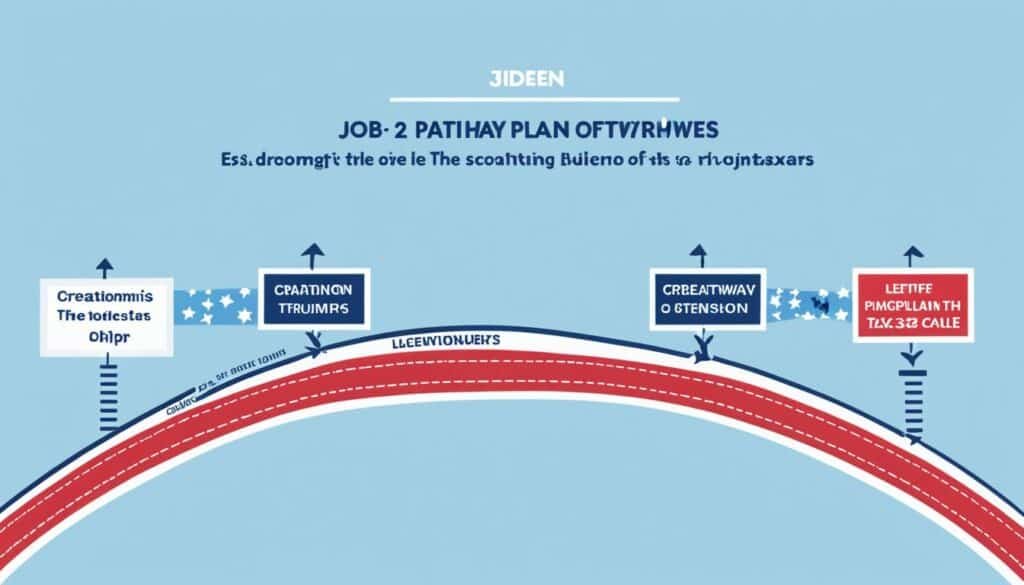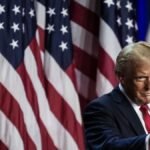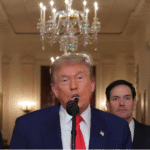Biden Vs Trump: The 2020 US election was vital, especially for the economy. Joe Biden and Donald Trump had different plans for the nation’s financial future. Most Americans trusted Trump more with the economy. Yet, when we check the actual facts, things are not so clear-cut.
This piece aims to fully compare both presidents’ economic strategies and their outcomes. By the end, we hope to figure out which leader’s approach would benefit the US more.
Key Takeaways
- The 2020 US presidential election presented two vastly different economic visions for the country, with Biden and Trump offering distinct policy proposals.
- Surveys suggest Americans have more confidence in Trump’s economic management, but economic data reveals a more nuanced picture of the nation’s economic performance under both administrations.
- This article will analyze the economic plans, policies, and outcomes of the Biden and Trump presidencies to determine which approach may be better for the US economy.
- The analysis will cover key areas such as inflation, job creation, trade, infrastructure investment, and the role of the Federal Reserve.
- The goal is to provide a comprehensive and objective assessment to help readers make an informed decision on which economic plan may be more beneficial for the United States.
Biden’s Economic Agenda: Battling Inflation and Driving Growth
Since taking office, President Biden has worked hard to steer the economy post-COVID. Millions lost their jobs, hitting levels similar to the Great Depression, but Biden swiftly moved. He put forth a detailed plan combining a mask mandate, more testing, and a $1.9 trillion aid package.
Biden’s Plan to Combat Inflation
To fight high inflation, Biden has mapped out a plan. This plan involves undoing certain tax cuts from the Trump era, fixing tax loopholes, and cutting off fossil fuel subsidies. The aim is to gather funds for his $1.3 trillion infrastructure plan, meant to boost economic growth and jobs.
Biden’s Strategies for Economic Recovery and Job Creation
Some have criticized Biden’s approach, but stability is returning to the economy. GDP growth has been steady at 2%, and unemployment is at its lowest in half a century, with only 3.5% jobless in 2022.
“The Biden administration’s focus on combating inflation and driving economic growth through infrastructure investment has been a key part of their economic agenda.”
The country is still fighting the pandemic’s economic fallout. Biden’s moves to combat inflation and stimulate growth are under close scrutiny by many, including those in government, business, and the general public.
Trump’s Economic Legacy: Tax Cuts, Trade Wars, and Deregulation
Former President Donald Trump had big plans for the country’s economy. He pushed for major tax cuts, launched trade wars, and encouraged deregulation. These actions significantly altered the economic landscape of the US.
Trump’s Tax Cuts and Impact on the National Debt
In 2017, a major tax reform was put in place by Trump. It dropped the corporate tax rate from 35% to 21% and reduced individual tax rates. Trump believed this would boost the economy enough to cover the lost tax revenue. However, studies later found this wasn’t the case. The US national debt grew considerably because of these policies.
Trump’s plans included cutting spending in areas like healthcare, which also added to the national debt.
| Metric | Pre-Trump (2016) | Post-Trump (2020) |
|---|---|---|
| Federal Debt Held by the Public | $14.2 trillion | $21.0 trillion |
| Federal Deficit | $585 billion | $3.1 trillion |
The table data shows a big jump in national debt and deficit during Trump’s time. His tax policies were a major factor in this increase.
His decision to start trade wars, especially with China, had both good and bad effects. The trade deficit improved at first but went back up due to the pandemic. The pandemic severely impacted global supply chains, causing the trade deficit to grow again.
“Trump’s tax cuts and trade wars have left a complex legacy, with both positive and negative consequences for the US economy.”
Today, President Biden’s team is still dealing with the effects of Trump’s economic moves. The conversation about whether Trump’s actions were beneficial or not continues.
Analyzing the Economic Performance: Growth, Unemployment, and Inflation

The Biden and Trump administrations faced various economic issues. These include growth, job changes, and challenges with prices. Looking at key economic signs helps us see how they did and what was hard.
Economic Growth Rates Under Biden and Trump
Under Trump, the economy did okay with both good and bad times. 6.6 million jobs were made in the first three years. This wasn’t as strong as before. The economy grew about 2% on average.
The COVID-19 pandemic made the economy shrink by 2.2% in 2020. Now, under Biden, things are looking up. In 2021, a huge 7.27 million jobs were created.
Navigating Inflationary Pressures
Inflation hit a high under Biden in 2022, at 9.1%. But then it started to go down. The U.S. handled inflation better than other big countries. This was helped by raising interest rates.
The economy under both Biden and Trump faced big challenges. These included growth, job changes, and dealing with inflation. By knowing these, we can judge how well their plans worked for the economy.
“The economic landscape under the Biden and Trump administrations has been characterized by a mix of growth, employment fluctuations, and inflationary pressures.”
Biden Vs Trump: Contrasting Approaches to Infrastructure Investment

Both Biden and Trump see the need to update our country’s infrastructure. They both know it needs a lot of money to improve things like roads and bridges. But, they have very different ways of dealing with this challenge.
Trump wanted to invest $2 trillion but didn’t explain where the money would come from. Biden proposed a 10-year, $1.3 trillion plan. His plan aims to fight climate change, create jobs, and fix infrastructure. It would be paid for by changing some tax laws that benefited the rich during Trump’s time in office.
There’s a call for action from both sides of politics to improve our infrastructure. But Republicans have hesitated to spend on it in the same bills meant to help with the pandemic. They say this help makes the bill too costly.
“Substantial infrastructure investment could provide a much-needed boost to the US economy, driving growth and job creation, though the details and implementation of such plans will be crucial.”
Many experts agree that a well-planned infrastructure effort can boost the economy and create jobs. But, the way these plans are made and carried out is key to their success. It all depends on the choices our leaders make.
The Biden administration wants to focus on infrastructure. This is very different from what Trump planned. The discussion around these topics is critical. It will shape our nation’s future growth and how competitive we are.
The Impact of Biden’s American Rescue Plan and Trump’s Stimulus Measures
The COVID-19 pandemic hit the US economy hard. Both the Trump and Biden administrations responded with big stimulus plans to help. These plans were meant to steady the economy and promote growth.
Under Trump, several relief bills were approved. The largest was the $2.2 trillion CARES Act. It aimed to support people, businesses, and local governments hit by the pandemic’s effects.
Evaluating the Effectiveness of Economic Stimulus Efforts
The results of these economic boosts are still debated. Trump’s efforts at the start of the pandemic helped. But Biden’s $1.9 trillion American Rescue Plan from 2021 sped up the recovery.
This plan included giving direct money to people, boosting unemployment pay, and helping local governments. Such heavy government spending is thought to have inspired robust job growth and increased GDP.
Yet, this massive spending likely played a part in a sharp rise in inflation, which began to fall back in 2022. Economists are studying the longer-term effects on the US economy.
| Measure | Size | Key Provisions | Impact |
|---|---|---|---|
| Trump’s CARES Act | $2.2 trillion |
|
Helped stabilize the economy in the early stages of the pandemic |
| Biden’s American Rescue Plan | $1.9 trillion |
|
Accelerated economic recovery, contributing to record job creation and GDP growth, but also linked to surge in inflation |
The lasting effects of this funding are still studied. Experts keep a close eye on what it means for the US economy.
Biden Vs Trump: Divergent Policies on Healthcare and Social Security
The Biden and Trump administrations had different stances on healthcare and social security. These differences have directly affected American families.
Trump wanted to cut spending on Medicare and Medicaid in his 2021 budget. However, he aimed to protect Social Security and Medicare. On the other hand, Biden promised to make the Affordable Care Act stronger. He also wants to lower Medicare’s age from 65 to 60.
Biden’s healthcare plans could cost $750 billion in a decade. They aim to help 97% of Americans. Trump mainly focused on making drugs cheaper and stopping surprise bills. This shows the big differences in their economic plans, with Biden aiming to strengthen social support and Trump focusing on saving money.
“The contrast between the Biden and Trump administrations’ healthcare and sosocial security policies is stark, reflecting their vastly different vsions for the role of government in supporting American families.”
These policy differences will deeply affect healthcare, social security, and the overall economic setting. They will play a big part in the future of the United States.
Trade and Globalization: Biden’s Alliance-Building Vs. Trump’s Unilateralism
President Joe Biden and former President Donald Trump have different views on trade. Trump focused on protecting America alone, using “America First.” However, Biden leans towards working with other countries, aiming for global economic solutions.
Assessing the Impact of Trade Policies on the US Economy
Trump’s solution was tariffs, especially aimed at China. He hoped to fix America’s trade deficit and help US companies. But, these tariffs didn’t work well. They didn’t improve the economy, which suffered job losses and more expensive products.
On the other hand, Biden wants to join forces with other nations, especially when facing China. Many believe this team effort could lead to better outcomes. Using tariffs alone can sometimes backfire, hurting the US rather than helping it.
“The Trump administration’s trade wars have proven to be a drag on the US economy, while Biden’s focus on alliance-building could yield more positive results for American workers and businesses.”
The US economy is dealing with globalization and trade policy challenges. Biden and Trump’s different trade approaches will keep sparking discussions and studies.
Wage Growth and Job Creation: A Comparative Analysis

The economic performance of the US is key for the Biden and Trump terms. Each president used different strategies that affected wage growth and job making.
Trump saw the US make 6.6 million jobs in the first three years. This was good but not outstanding. Under Biden, 7.27 million new jobs were created in 2021, setting a new record.
Both focused on increasing wages. Trump centered on the “Buy American, Hire American” plan. Biden aimed to lift the minimum wage to $15 per hour. Yet, these efforts mainly helped younger and lower-income workers.
| Metric | Trump Administration | Biden Administration |
|---|---|---|
| Job Creation (First 3 Years) | 6.6 million | 7.27 million (2021 only) |
| Wage Growth | Focused on “Buy American, Hire American” | Pushed for $15 minimum wage |
| Wage Growth Distribution | Uneven, with younger and low-income workers seeing larger gains | Uneven, with younger and low-income workers seeing larger gains |
Many experts believe that both presidents focused on job making and raising wages. But, how well their efforts worked and if they were fair are still being judged. As the economy changes, how these policies affect American workers will be very important. It will show how successful these strategies were.
The Role of the Federal Reserve in Shaping Economic Outcomes
The federal reserve plays a major part in leading the economy, especially during times marked by the Biden and Trump presidencies. It acts as the main financial authority in the United States. Through its strategies, the Federal Reserve affects interest rates, the economy’s success, and the country’s financial path.
Monetary Policy and Interest Rate Decisions Under Biden and Trump
Amid the COVID-19 outbreak, the Federal Reserve took bold steps to help the falling economy. It did this by lowering interest rates and buying assets. Such moves helped soften the economic impact of the pandemic crisis.
In Biden’s time, the focus shifted towards reducing high inflation and preventing a deep economic downturn. To do this, the Federal Reserve increased interest rates. But, keeping a good balance is tough. Its choices greatly influence jobs, how much people spend, and the US economy’s well-being.
“The Federal Reserve’s actions have been largely independent of the White House, but its decisions have had significant implications for the trajectory of the economy, employment, and the financial markets, making it a key factor in the comparative analysis of Biden and Trump’s economic performance.”
The federal reserve makes decisions on its own, away from political pressures. Still, its choices deeply affect economic results in the times of both Biden and Trump. This highlights the central bank’s vital role in changing the country’s economic course.
Biden Vs Trump: Which Economic Plan Is Better For The US?

With the 2024 presidential election nearing, Americans are deeply focused on the economy. They’re comparing President Biden’s plans with those of former President Trump. The financial future of the nation hangs in the balance.
Trump focused on tax cuts and deregulation to boost jobs and investments. But, his methods led to a big national debt. In contrast, Biden is pushing for growth with a focus on infrastructure and clean energy. Yet, some worry these efforts may make inflation worse.
Choosing the best path means considering many factors. Job creation, inflation, and government debts are key. As the American electorate prepares to make their choice, this debate is likely to continue to be a key consideration for many voters.
“The determination of which economic plan is better for the US will depend on voters’ priorities and their assessment of the tradeoffs between factors like job creation, inflation, debt, and the role of government in the economy.”
Comparing Biden and Trump’s Economic Legacies
Both Trump and Biden took on tough times, such as the COVID-19 pandemic. Yet, their economic strategies and outcomes were very different. Trump’s focus was on boosting investment and creating jobs. But, it also brought a bigger national debt. On the other hand, Biden invests in the future through infrastructure and green initiatives, hoping to improve economic fairness. Yet, these actions can also lead to higher inflation.
- Trump’s tax cuts and reduced regulations aimed to increase investment and jobs. But, they grew the national debt.
- Biden’s emphasis is on upgrading infrastructure, green energy, and social programs. This is done to enhance long-run economic benefits and fairness. However, this approach also risks higher inflation.
As we near the 2024 election, the debate around the economy will heat up. Americans will carefully weigh all the issues. From job creation to economic fairness, every aspect matters. The decision on the best economic plan for the US is crucial.
Also Read: The Los Angeles School District Has Authorized A Ban On Cellphones And Social Media
Conclusion
The difference between Biden and Trump’s economic plans is not simple. Both dealt with challenges like COVID-19 and high inflation. Yet, they took different routes and saw varied outcomes.
Trump cut taxes and removed regulations to boost business and job growth. But, this also swelled the national debt. Biden is focusing on building infrastructure, promoting clean energy, and funding social programs. He hopes to grow the economy in the long run and make it fairer. However, his actions have also fueled inflation.
In the end, deciding on the best plan depends on what voters see as most crucial. They must consider things like creating jobs, controlling inflation, managing debt, and the government’s part in the economy. As we get closer to the 2024 presidential race, these discussions will likely stay at the forefront for American voters.
FAQs
What are the key economic plans and policies of President Joe Biden and former President Donald Trump?
President Biden is working on fighting inflation and boosting infrastructure. He’s also expanding social programs. Former President Trump focused on cutting taxes, rolling back regulations, and pushing for trade policies that protect the U.S.
How have Biden and Trump’s economic policies impacted job creation, wage growth, and the national debt?
Biden’s administration broke a record by adding 7.27 million jobs in 2021. Both presidents have improved job numbers. However, wage growth and national debt aren’t simple. Trump’s tax cuts led to more debt.
What are the key differences between Biden and Trump’s approaches to healthcare, social security, and infrastructure investment?
Biden wants to grow the Affordable Care Act and keep social security safe. Trump aimed to cut healthcare programs. Both supported improving infrastructure, but they used different paths and aims to fund it.
How have the Biden and Trump administrations responded to the COVID-19 pandemic’s economic impact, and how effective were their respective stimulus measures?
Both presidents put forward big economic boosts. Biden’s plan, the American Rescue Plan, helped the recovery pick up speed. But, we’re still checking what these efforts mean for inflation in the long run.
What role has the Federal Reserve played in shaping economic outcomes under Biden and Trump, and how have their policy decisions affected the economy?
The Federal Reserve made moves to deal with tough economic times, like fighting high inflation by changing interest rates. These actions have had a big effect on the economy under both leaders.
How do Biden and Trump’s trade policies differ, and what has been the impact on the US economy?
Trump leaned toward protecting America through tariffs and trade standoffs. Biden has talked about joining forces with other countries. Many believe Biden’s team approach can help more in the future.
Which economic plan, Biden’s or Trump’s, is better for the US economy, and what factors should voters consider when evaluating the two approaches?
The right economic plan depends on what’s important to voters. They should think about how the plans aim to create jobs, handle inflation and debt, and what the government’s role in the economy should be.
Source Links
- https://www.investopedia.com/comparing-the-economic-plans-of-trump-and-biden-4843240
- https://www.dw.com/en/fact-check-is-biden-or-trump-better-for-the-us-economy/a-68755181
- https://www.vox.com/politics/24094752/biden-trump-strong-economy-2024-inflation




